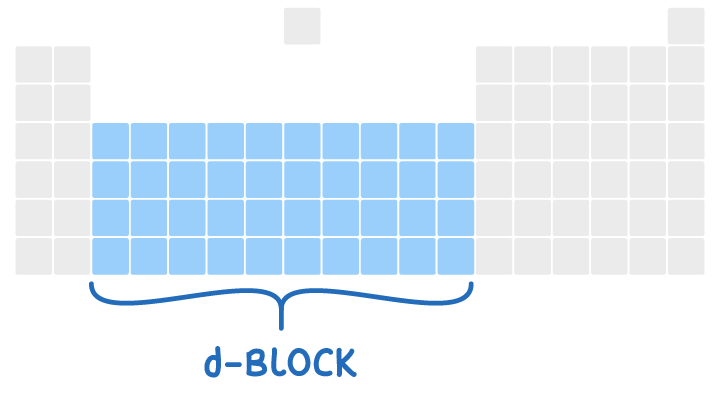The General Properties of Transition Metals
This lesson covers:
- What transition elements are
- The electron configurations of transition elements
- The chemical properties of transition elements
Transition elements are found in the d-block
Most of the elements found in the middle section of the periodic table are classified as transition elements or transition metals. This section is known as the d-block. The highest energy electrons in transition elements are found in the d sub-shell.

The main transition elements we will focus on are the metals in the first row of the d-block, from titanium (Ti) to copper (Cu).
Transition elements have a partially filled d sub-shell
Transition elements are defined as a d-block elements that form one or more stable ions with partially filled d orbitals. This means transition elements have electron configurations with between 1 and 9 electrons in their d sub-shell.
Scandium and zinc are found in the d-block but do not meet the definition of a transition element:
- Scandium only forms Sc3+ ions with an electron configuration of [Ar], meaning an empty d sub-shell.
- Zinc only forms Zn2+ ions with an electron configuration of [Ar]3d10, meaning a full d sub-shell.
Electron configurations of transition elements
The electron configurations of the period 4 transition metal atoms are:
| Element | Electron configuration |
|---|---|
| Titanium | [Ar]3d24s2 |
| Vanadium | [Ar]3d34s2 |
| Chromium | [Ar]3d54s1 |
| Manganese | [Ar]3d54s2 |
| Iron | [Ar]3d64s2 |
| Cobalt | [Ar]3d74s2 |
| Nickel | [Ar]3d84s2 |
| Copper | [Ar]3d104s1 |
Chromium has the configuration [Ar]3d54s1 rather than [Ar]3d44s2 because a half-filled d sub-shell (d5) provides greater stability.
Similarly, coopper has the configuration [Ar]3d104s1 rather than [Ar]3d94s2 because a full d sub-shell (d10) provides greater stability.
s electrons are removed first when ions are formed
When transition metal atoms form positive ions, the 4s electrons are removed first, followed by the 3d electrons.
For example, iron can form both Fe2+ and Fe3+ ions:
- Fe = [Ar]3d64s2
- Fe2+ = [Ar]3d6
- Fe3+ = [Ar]3d5
Useful chemical properties
Transition elements have several useful chemical properties, including:
- Existing in variable oxidation states (e.g. manganese exhibits oxidation states from +7 to +2).
- Acting as catalysts (e.g. iron is used as a catalyst in the Haber process).
- Forming coloured ions (e.g. chromium forms orange Cr2O72- ions and green Cr3+ ions).
- Forming complex ions
Transition elements show variable oxidation states because the 4s and 3d sub-shells have very similar energies, so only small amounts of energy are needed to remove differing numbers of electrons to form stable ions in different oxidation states.
The common oxidation states and colours of the ions formed by first row transition elements are summarised below:
| Oxidation state | +7 | +6 | +5 | +4 | +3 | +2 |
|---|---|---|---|---|---|---|
| Titanium | Ti3+ (purple) | Ti2+ (violet) | ||||
| Vanadium | VO2+ (yellow) | VO2+ (blue) | V3+ (green) | V2+ (violet) | ||
| Chromium | Cr2O72- (orange) | Cr3+ (green)* | ||||
| Manganese | MnO4- (purple) | MnO42- (green) | Mn2+ (pale pink) | |||
| Iron | Fe3+ (yellow) | Fe2+ (pale green) | ||||
| Cobalt | Co2+ (pink) | |||||
| Nickel | Ni2+ (green) | |||||
| Copper | Cu2+ (pale blue) |
*Cr3+ is technically pale purple, but in practice aqueous Cr3+ solutions usually look green.